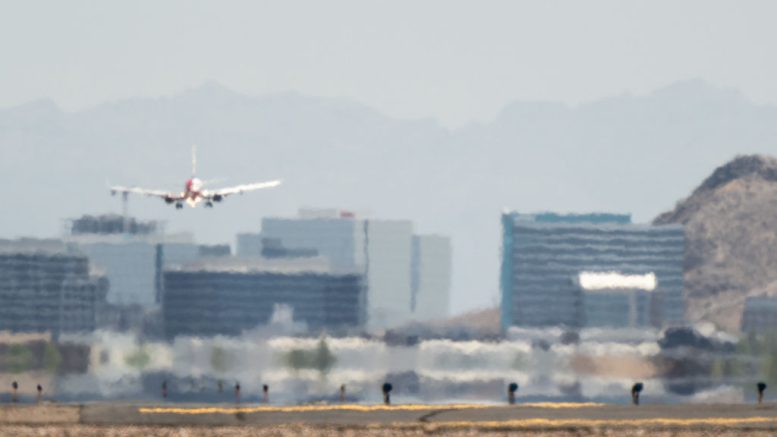Add shaky planes, weather delays and cancellations to our new reality under unfriendly warming skies.
By Mark Schapiro, Capital & Main
This story is produced by the award-winning journalism nonprofit Capital & Main and co-published here with permission.
Cups bouncing off trays, flight crews strapping on to their seats midflight, bumps in the sky: Into this zig-zagging volatility we fly.
That is, if you make it off the ground.
This past weekend — high season for summer travel — about 2,450 flights were cancelled across the country, driven by the sequence of rollicking extremes wreaking chaos in our lower atmosphere. In July they came like plagues: the Canadian wildfires that choked much of New England; the rainstorms that deluged New England and the Eastern Seaboard; and the blistering heat wave across the Southwest.
All these events came in a two week span in July — atmospheric dissonance raged. Of course they all overlapped, and as if we need reminding, they’re all part of a continental (and global) weather system: Havoc wreaked in New England does not take long to ripple across the flight patterns in and out of L.A. or any other destination.
Is it bad luck, or is it a pattern?
The only thing predictable about that string of biblical-scale disasters was that it has been predicted. For more than a decade, scientists have identified the fundamental characteristic of our greenhouse gas-soaked atmosphere: While the temperatures are rising, just how much they rise and just how much disruption they cause depends on where you’re located. But for everyone, no matter where on the planet, our primary experience of climate change is one of volatility, experienced by everyone and everywhere and all at once.
The disruptions to the atmospheric equilibrium are altering weather patterns into patterns we’ve never seen before. Which is why all the records — for heat, rain, smoke, windstorms — are being broken with every new weather cataclysm. Frequency of such extreme events — fires, floods, heat waves and intense rainstorms (warmer temperatures mean that more water is absorbed in the atmosphere, until it’s not) — are attributable, to a significant degree, to the ever-thickening overcoat of greenhouse gases enveloping the Earth. And we feel that most vividly and directly in airplanes, which fly directly into the maelstrom above.
The turbulent skies are affecting not only when or whether we fly, but how. Ocean currents are shifting because of rising temperatures in the waters below our feet, and a similar shift is underway in the air currents above our heads.
Turbulence starts with a domino effect: Higher atmospheric temperatures fueled by CO2 and other greenhouse gas emissions are dramatically altering wind patterns. It’s a newly dynamic world up there, as this paper in Nature Climate Change points out, of colliding downdrafts and updrafts. Warmer air pushes colder air upwards, where it heats and then comes down again. Those vertical wind shears, deeply destabilizing to the cruising altitudes most often used by commercial airplanes, are made more erratic and fierce by the changing climate.
The amount of strong clear air turbulence over the North Atlantic and North America increased by 55% between 1979 and 2020, according to research published in June in Geophysical Research Letters. The study assigns most of the responsibility to the increasing concentration of CO2 and other greenhouse gases in the atmosphere — in other words, to the fossil fuel industries and our consumption of their products.
Climate change is fed by cause-effect loops over time spans that are getting shorter. For example, rising temperatures melt glaciers, ocean waters expand, and those warmer waters in turn contribute to the melting of more glaciers. Still, all the stages of that cause-effect-cause dynamic are hard to experience unless you’re driving a fossil-fueled car on the edge of a melting glacier, and on a beach with a rising sea at the same time.
Airplanes take us straight into the very same atmosphere where air currents are being sent into new patterns because of the distorting impacts of greenhouse gases — an abundance of which will be coming from your airplane. Airplanes place us in the middle of the climate feedback loop.
From the exhaust of planes comes a cocktail of greenhouse gas-enhancing substances, including CO2 and nitrous oxide; aviation contributes 3.5-4% of global greenhouse gas emissions. So while strapped to our airplane seats, bouncing along eight miles high, we’re also contributing in real time to our own and fellow passengers’ unease as the plane rattles and hums through the turbulence we’ve contributed to creating.
For at least a decade, scientists and environmental campaigners have been pushing regulatory authorities in the U.S. to limit the greenhouse gas emissions of airplanes, which are now subject only to the voluntary guidelines offered by the International Civil Aviation Organization. In 2021, the Center for Biological Diversity and Earthjustice sued the EPA to tighten the regulations governing aviation emissions. The case is still winding its way through the courts, and kicking up plenty of data on airplanes’ disruptive effects on climate along the way.
After a brief decline at the height of the pandemic, airline emissions have been growing steadily and are expected to triple by 2050.
Brace yourself for bumpier rides.
Copyright 2023 Capital & Main


Be the first to comment on "Bumps in the air: What’s climate change got to do with It?"